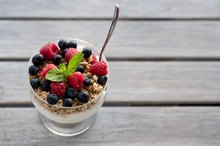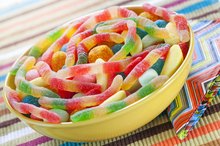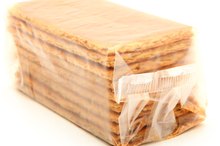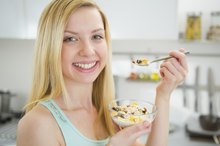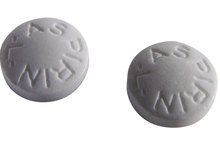What does fact checked mean?
At Healthfully, we strive to deliver objective content that is accurate and up-to-date. Our team periodically reviews articles in order to ensure content quality. The sources cited below consist of evidence from peer-reviewed journals, prominent medical organizations, academic associations, and government data.
The information contained on this site is for informational purposes only, and should not be used as a substitute for the advice of a professional health care provider. Please check with the appropriate physician regarding health questions and concerns. Although we strive to deliver accurate and up-to-date information, no guarantee to that effect is made.
Raisin Bran Cereal Ingredients
Kelloggs brand products are made in 18 countries and sold all over the world. In addition to baking products, beverages, cookies, crackers, and fruit snacks, Kelloggs currently produces 57 different varieties of cereals. Made from whole grains, raisins and sugar, Raisin Bran cereal can be a high fiber addition to a healthy diet.
Top Five Ingredients
The FDA states that the ingredients on a product's food label must be listed in descending order of predominance. The first ingredient in Raisin Bran cereal is whole grain wheat. This means that the product contains more whole grain wheat than any of the other ingredients listed. In addition to whole grain wheat, Raisin Bran also contains raisins, wheat bran, sugar, and high fructose corn syrup 1. While there is controversy regarding the safety of high fructose corn syrup, MayoClinic.com notes that there is not enough research at this time to say that high fructose corn syrup is any worse for you than other types of sugars 1.
- The FDA states that the ingredients on a product's food label must be listed in descending order of predominance.
B Vitamins
Nutritional Information for Dubble Bubble Gum
Learn More
A serving of Raisin Bran cereal meets 25 percent of your daily value of six different B vitamins. The cereal is made with added thiamin, riboflavin, B6, B-12, niacinamide, and folic acid. B vitamins are needed to obtain and use energy from the diet; they are also needed in the formation of red blood cells. While B vitamins are found in foods such as meats, eggs, and dairy, many cereals like Raisin Bran are fortified with B vitamins to help meet daily B vitamin needs and prevent deficiency-related diseases like anemia.
- A serving of Raisin Bran cereal meets 25 percent of your daily value of six different B vitamins.
- While B vitamins are found in foods such as meats, eggs, and dairy, many cereals like Raisin Bran are fortified with B vitamins to help meet daily B vitamin needs and prevent deficiency-related diseases like anemia.
Other Vitamins and Minerals
In addition to B vitamins, Raisin Bran cereal also contains vitamin A, vitamin D, zinc and iron. A serving of the cereal meets 10 percent of your daily zinc, vitamin A and vitamin D requirements, along with 25 percent of your daily iron needs. The vitamin D contained in Raisin Bran helps the body absorb and use the calcium in the milk that you add to your cereal. Together, vitamin D and calcium work to maintain strong bones. Vitamin D is also important for nerve, muscle, and immune system health.
- In addition to B vitamins, Raisin Bran cereal also contains vitamin A, vitamin D, zinc and iron.
- A serving of the cereal meets 10 percent of your daily zinc, vitamin A and vitamin D requirements, along with 25 percent of your daily iron needs.
Additional Flavorings and Sweeteners
Ingredients in McDonald's Yogurt Parfait
Learn More
For added flavor and sweetness, Raisin Bran cereal is also made with salt, malt flavoring and invert sugars. Food.com states that invert sugar is a sweetener that is made by heating table sugar and adding a small amount of acid 3. This causes the sucrose to break down into glucose and fructose, resulting in smaller sugar crystals. The smaller crystals dissolve more quickly and help to create a smoother product.
- For added flavor and sweetness, Raisin Bran cereal is also made with salt, malt flavoring and invert sugars.
- Food.com states that invert sugar is a sweetener that is made by heating table sugar and adding a small amount of acid 3.
Related Articles
References
- MayoClinic.com: High Fructose Corn Syrup
- National Institutes of Health Medline Plus: Vitamins
- Food.com Kitchen Dictionary: Invert sugar
- FoodData Central
- FoodData Central
- FoodData Central
- Identifying Practical Solutions to Meet America’s Fiber Needs: Proceedings from the Food & Fiber Summit
- Dietary fiber intake and risks of proximal and distal colon cancers
- The effect of fiber on satiety and food intake: a systematic review - PubMed
- The health benefits of dietary fiber: beyond the usual suspects of type 2 diabetes, cardiovascular disease and colon cancer
- FoodData Central
- FoodData Central
- FoodData Central
- Impact of Frequency of Multi-Vitamin/Multi-Mineral Supplement Intake on Nutritional Adequacy and Nutrient Deficiencies in U.S. Adults
- The Contribution of Fortified Ready-to-Eat Cereal to Vitamin and Mineral Intake in the U.S. Population, NHANES 2007–2010
- Folate and neural tube defects: The role of supplements and food fortification
- Iron Deficiency Anemia: A Common and Curable Disease
- 2015-2020 Dietary Guidelines | health.gov
- Sugar
- FoodData Central
- FoodData Central
- FoodData Central
- Risk Factors Contributing to Type 2 Diabetes and Recent Advances in the Treatment and Prevention
- Relationship between Added Sugars Consumption and Chronic Disease Risk Factors: Current Understanding
- Sugars in diet and risk of cancer in the NIH-AARP Diet and Health Study
- Role of Sugar and Sugar Substitutes in Dental Caries: A Review
- The Evidence for Saturated Fat and for Sugar Related to Coronary Heart Disease - PubMed
- Added sugars drive coronary heart disease via insulin resistance and hyperinsulinaemia: a new paradigm
Writer Bio
Emily Creasy began writing professionally in 2010. As a registered and licensed dietitian her writing focuses on weight loss, disease-specific diets and diet-friendly cooking. She holds a Bachelor of Science in human nutrition, foods and exercise from Virginia Tech and a Master of Science in dietetics from James Madison University.

